#( branch 1.2 )
Text

Dozens of Google employees began occupying company offices in New York City and Sunnyvale, California, on Tuesday in protest of the company’s $1.2 billion contract providing cloud computing services to the Israeli government.
The sit-in, organized by the activist group No Tech for Apartheid, is happening at Google Cloud CEO Thomas Kurian’s office in Sunnyvale and the 10th floor commons of Google’s New York office. The sit-in will be accompanied by outdoor protests at Google offices in New York, Sunnyvale, San Francisco, and Seattle beginning at 2 pm ET and 11 am PT.
Tuesday’s actions mark an escalation in a series of recent protests organized by tech workers who oppose their employer’s relationship with the Israeli government, especially in light of Israel’s ongoing assault on Gaza.
Just over a dozen people gathered outside Google’s offices in New York and Sunnyvale on Tuesday. Among those in New York was Google cloud software engineer Eddie Hatfield, who was fired days after disrupting Google Israel’s managing director at March’s Mind The Tech, a company-sponsored conference focused on the Israeli tech industry, in early March. Several hours into the sit-ins on Tuesday, Google security began to accuse the workers of “trespassing” and disrupting work, prompting several people to leave while others vowed to remain until they were forced out.
The 2021 contract, known as Project Nimbus, involves Google and Amazon jointly providing cloud computing infrastructure and services across branches of the Israeli government. Last week, Time reported that Google’s work on Project Nimbus involves providing direct services to the Israel Defense Forces. No Tech for Apartheid is a coalition of tech workers and organizers with MPower Change and Jewish Voice for Peace, which are respectively Muslim- and Jewish-led peace-focused activist organizations. The coalition came together shortly after Project Nimbus was signed and its details became public in 2021.
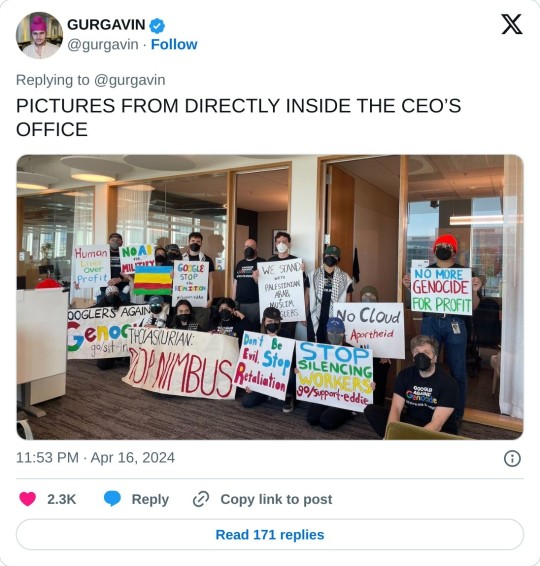
You can read No Tech for Apartheid's open letter here.
#yemen#jerusalem#tel aviv#current events#palestine#free palestine#gaza#free gaza#news on gaza#palestine news#news update#war news#war on gaza#apartheid#gaza genocide#genocide#boycott divest sanction#boycott google#bds movement#Edited
5K notes
·
View notes
Text
Microsoft disponibiliza Windows 11 Insider Preview Build 25290
A Microsoft anunciou hoje, via Windows Blog, a disponibilização do Windows 11 Build 25290.1000 no âmbito do Windows Insider Program, para todos os utilizadores cujos PCs se encontram registados no Dev Channel.
Esta é a 31ª build da Active Development Branch a ser disponibilizada aos membros do Programa que entraram na RS_PRERELEASE.
(more…) “”

View On WordPress
#Active Development Branch#Badges on Start Menu#Dev Channel#Insider Preview#Phone Link#RS_PRERELEASE#Spotify#vNext#Windows 11#Windows App SDK 1.2#Windows Update
1 note
·
View note
Text
PENACONY 2.1 SPOILERS /
[basically a more elaborate version of my twt thread on this]
I don't think I'm the first or only person to say this, but I do think Gallagher is v likely a memory zone meme
EDIT: heres pt 1.2 with additional evidence
Sunday deduces that Gallagher is an amalgamation of fifty-one Family members, who he's inherited physical traits from to create the appearance he has now.
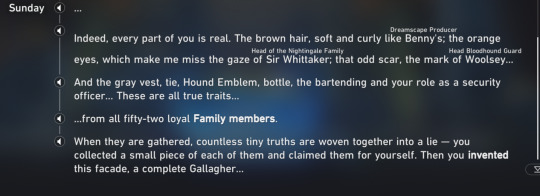
Gallagher alludes in his own story that he may not be human

In short, Memory Zone Memes are amalgamations of multiple fragments of the Memory Zone, all have reflections of different memories, cognitions and emotions.


A meme in definition is when something, usually ideas, culture or behaviour is passed to another person through imitation or non-genetic means.
It makes sense for Gallagher, as he mimicked the physical traits of Family members without taking them or that trait away - these NPCs are very much fine and you can interact with them. It's more like a copy-paste onto himself.
Other little details include:
-This could change in the future depending on if we get any fire units, but for Gallagher specifically, he takes the Raging Heart materials - which is harvested from a Memory Zone Meme-type enemy. This one's a bit of a stretch but it fits nonetheless
-His signature colour is magenta - shown in his clothing, his marketing materials and in the VFX of his attacks, his claw and his brew. This colour is specifically his and not something he had inherited from someone else.

Memory Zone Memes, especially "Something Upon Death" have stark magenta/purple/pink eyes and cores. When seen from afar or at least in a general sense, the shades are similar enough
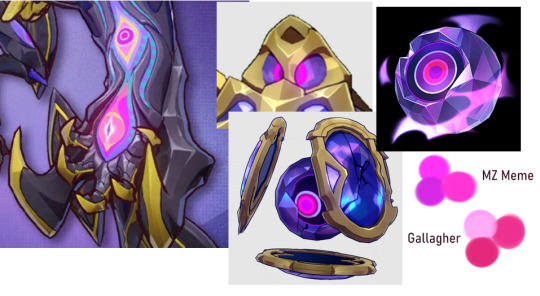
-The writing style of Gallagher's stories feel strange, like different aspects of Gallagher's personality and life are on the outside looking in. Akin to a reflective surface giving off different reflections from different angles of the same subject. It adds to the idea that there are multiple aspects and fragments within Gallagher all looking within each other.
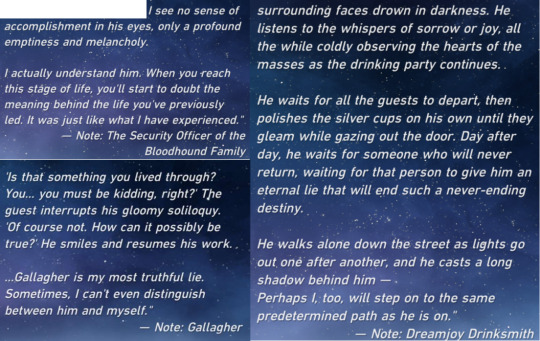
Mixology and The Dreamjolt Hostelry:

Gallagher's main interest outside of work is mixology. Like any culinary craft, there's an inherent science behind it, and it takes a lot of work and knowledge to craft well constructed cocktails and drinks. Symbolically, mixology complements Gallagher, as he himself is a combination of a diverse range of people. When you view these inherited traits isolated, you know they come from someone real - but when put together, they form One Complete Gallagher - cohesive and seamless.
While you can say the same for different branches of culinary arts, mixology in particular symbolically represents Gallagher the most. This is just from a layman's perspective but when I view the same with cocktails - from a general inspection it's one cohesive drink even if from taste or watching the process, I know it's all made with different components.
Notably, when Gallagher talks about mixing drinks, he describes it as akin to combining different emotions, experiences and memories into a singular cocktail and it's reflective of both customer and bartender's own current state of being.
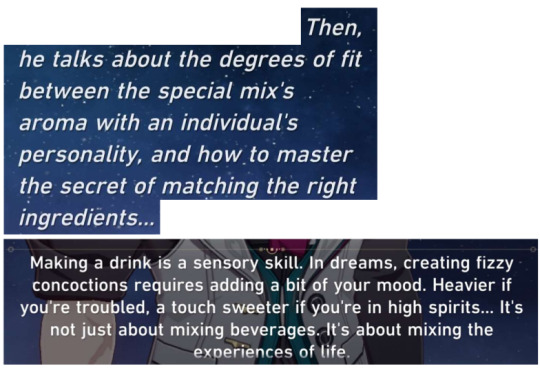
His philosophy on mixology links back to the concept of Memory Zone Memes, manifestations of fragmented memories, emotions and cognitions nestled into a vessel.
The reason why I bring up the Dreamjolt Hostelry is because of the Vignettes in a Cup event (spoilers for it). It's not explicit in his stories or voicelines, but going by the Trailblaze quest, it's implied that the Dreamjolt Hostelry is the lounge/bar he regulars for a drink or to hone his craft as he's v friendly and familiar to Siobhan and is seen in the 2.1 trailer to be serving a Dreamjolt Domescreen (whether it's Lady or not doesn't matter).

Dreamjolt Hostelry is in the sealed off dreamscape Reverie, where the corrupted Dreamjolt Troupe monsters and Memory Zone Memes reside. Notably, where you encounter Something Unto Death in key moments of the story.
I'd like to believe Gallagher is very comfortable with the company of monsters, going by the fact that he himself is non-human.
In Vignettes in a Cup, Siobhan explains that the reason why she mixes drinks for the Dreamjolt Troupe monsters is that it helps regulate their emotions - since the dreamscape is falling apart and in turn they have become unstable.
Gallagher himself in one of his idle animations drinks an unknown concoction from his hipflask once his scar starts acting up - in which it settles back down. It's hard to discern in this point in time how long this has been going for, but as a non-human entity (meme or not), the dreamscape's decay is also likely affecting Gallagher and thus he has to regulate himself.
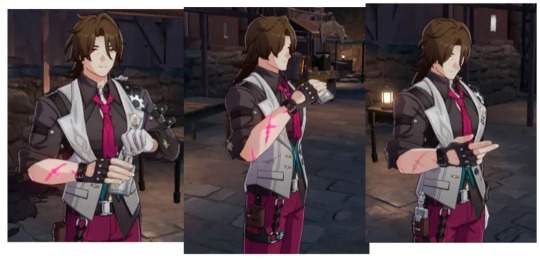
Why Do The Heathen Rage?:
In the mission "Why Do The Heathen Rage?" we learn a lot of the Watchmaker's secret history as well as a general run through of Gallagher's own personal story.
First off, a lot of Penacony's trailblaze mission titles are references to songs, literature and media relevant to the themes of Penacony and/or by American classical authors or poets (ie Heaven is a Place on Earth, Cat Among Pigeons, The Tell-Tale Heart).
Why Do The Heathen Rage is both based on Psalm 2.1 Old Testament, but also it's a fragment of an unfinished novel by Flannery O'Connor. Fragment of a novel -> Gallagher is made of fragments of different people -> Memory Zone Memes are fragments of (I'm booed off the stage for being a broken record).
The story tells of a man called Walter Tilman who lives on his family's farm. There he starts to write letters to different people - particularly to Oona Gibbs, a black civil rights activist. However, he writes to her under the guise of a black man, and writes with the intention of testing the commitment and integrity of her beliefs.
Going with what we know in hindsight, Gallagher is masquerading around as a human, likely as a Memory Zone Meme as we've realised hopefully by now that they're the monsters most likely to pull something of Gallagher's calibre off.
This is all I'm gonna talk about from "Why Do The Heathen Rage" mainly because my additional theories are based off leaks and are more speculative.
Bonus section: "Something Unto Death"
When it comes to Gallagher's connection to the Memory Zone Meme "Something Unto Death", a lot comes from his many symbols of death. This is just a bit of a bonus since we're talking about Gallagher likely being a Memory Zone Meme, we might as well address the elephant in the room as well.
For brevity, we'll call the little guy "Death Meme". Death Meme is a Memory Zone Meme created from the Dreamscape's fear of death and murder as "death" shouldn't be something that can happen in the dreamscape.

Gallagher has a FUCK ton of symbolism and nods to death. The most striking is that Gallagher's iconic "I'm Thirteen", which is the number for the Major Arcana "Death". (For additional reference I also think Thirteen could be the amount of Amber Eras he's lived in, or that he's at least 1300 years old. Also since he has a lot of dog theming, 13 dog years in human years is around 60-80 depending on the dog's size).

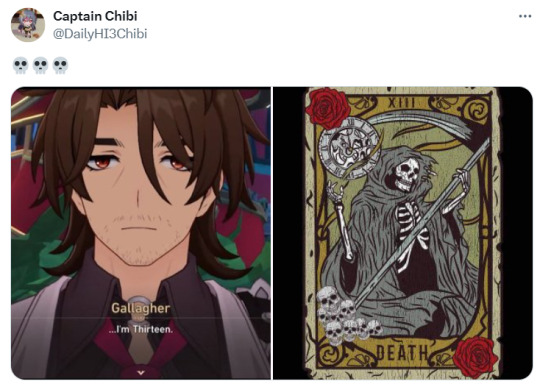
Additionally, thirteen is a common number to represent bad omens and misfortune - namely the well known Friday the 13th superstition, amongst other things.
When Gallagher makes you a drink, no matter what choices you make - the cocktail will have a memento mori/death/morbidly themed name and he will accompany most of them with a sardonic toast.
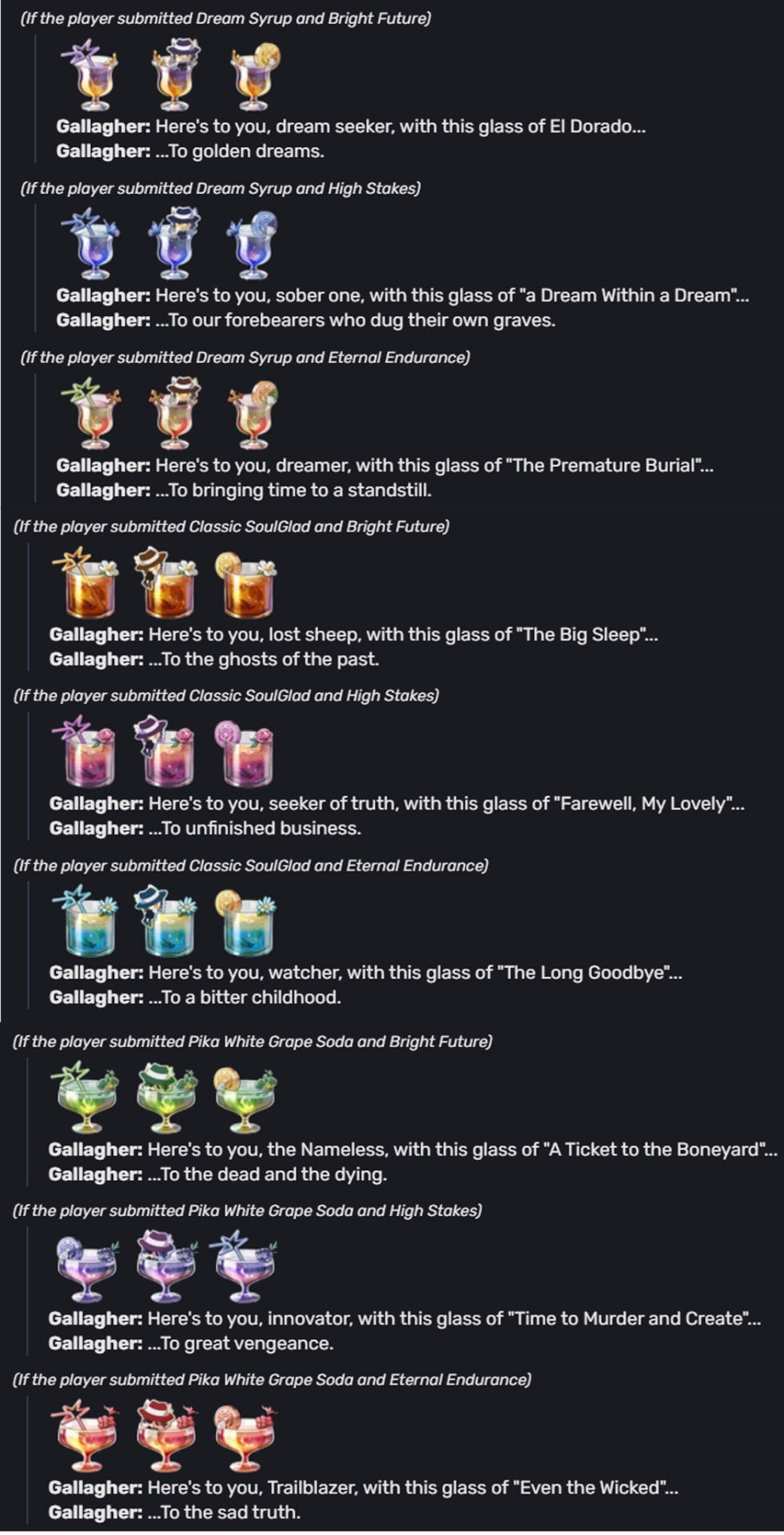

Gallagher's eidolons are names of different cocktails which fit his mixology theme. However, Corpse Reviver, Last Word, Death in the Afternoon and Blood and Sand are all death centric names, as if he couldn't get edgier enough.
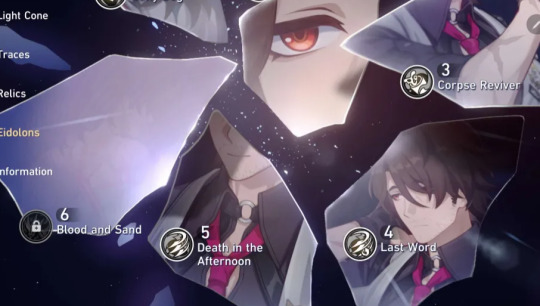
There's also the call into question his playstyle, where he's a much more aggressive battle healer than the likes of Luocha and is the first abundance character to provide debuffs on the enemy, and derives healing through damaging opponents.
Conclusion:
If you've read this far then I'm assuming you're as normal about Gallagher as I am. But yeah, there is so much to him I haven't touched on, his connections to the Enigmata, my continuation on this theory based on leaks and his shared past with Mikhail, what I think he'll do in the plot moving forward. This patch and its characters are themed around hiding secrets and that there's more than meets the eye. Gallagher in particular has proved to be the most mysterious of the trio, as while we've gotten a clear enough picture of both Acheron and Aventurine but there's still enough intrigue to keep them going, Gallagher's just given me more questions than answers man.
#honkai star rail#hsr gallagher#gallagher#honkai star rail theory#hsr theory#hsr spoilers#penacony spoilers#im normal about him (smile)
186 notes
·
View notes
Text
The Hour of the Wolf

Prologue
MASTERLIST
Summary: The dark hours before the end of Aegon Targaryen II
Warnings: Cursing, war, death, mentions of killings, genocide and war, threats, talks about bedding and non concensual sexual relationships, threats of mutilation, SPOILERS for ASOIAF, and Fire & Blood, also, might spoil House of the Dragon
Wordcount: 1.2 k
Notes: A bit short, but I'm setting a tone here

Corlys could sense the tension in the room, everyone, at least, the survivors, were dangerously quiet, they shared concerned looks between them all.
Alicent’s mouth always seemed to be twisted in inhumane ways, but now… the edges of her mouth almost falls down of her face by her chin
“All the traitors are going to die”, said Aegon, twisting his hands, playing with the rings he had placed in his fingers… trying to hide the fact that they were burnt, the skin melted. He used now high colored shirts and vests, but the still raw, tender skin that was never going to heal, could still be seen in the side of his face, no matter he had decided to let his wild hair ungroomed, fall long framed his chubby face.
“We will be overrun”, admitted Corlys, “A Northerner army, a big one, is passing trough Harrenhal right now, they had been joined by people in the Riverlands that still are faithful to Rhaenyra’s cause, and also from the Vale in the Narrow Sea, we will be defeated, and we will burn inside this walls”, he sentenced
“I think the Velaryon Fleet needs incentive, Lord Corlys, to face the traitors of the Vale”, two years ago, the council would have laughed to the drunken fool’s face that called himself King, but as they looked into his wild lilac eyes… no one laughed
Corlys was the only one to dare directly into his eyes
In defiance
Say it
He begged him with a silent threat in his dark eyes
Do it
Threaten me
“I think we need to send a little message…”, he continued, “I want my little nephew’s cock on a platter, and that little whore… in my chambers by the time we finish here, maybe that way, if we send them a set of sheets with my niece’s maidenhead in them, perhaps we will tell the fucking traitors what will happen to them all”
“Take the black, your grace, step down”
“I will kill them, to every last trace of my cunt of a half sister, i will take away the reason for their rebellion, they were be no other contender to the throne but me, and I will marry Cassandra Baratheon, she will give me true, strong heirs, worthy of the Iron Throne”
“Your grace”, he said slowly. “maybe, telling them of your marriage with the princess, instead of her bloodied sheets would be more effective”, he counseled
“He is right Aegon”, said Alicent softly, “an alliance between the two branches of the family will ease them, and Cregan Stark, when knowing Rhaenyra’s blood will sit on the Iron Throne one day, he will go back North”, she said hopefully, she placed her hand on his son forearm, but he pulled it, rejecting his mother’s touch
“Bring her to my chambers tonight”, he said to the Lord Commander of the Kingsguard, he didn't like it, but nodded nonetheless without saying anything
“Aegon”, reasoned Alicent, “she is very delicate, and an innocent in all of this”
“Isn’t she the daughter of my whore of a sister?”, he mocked, Alicent said nothing as she played with her fingers nervously, “isn’t she what you called her a thousand times over? a bastard?”
“That doesn’t mean… we will be surrounded”
“Call in Lord Borros then, they will attack the traitors from the back, and killed them against the city walls”, he mocked
“Lord Borros is dead your grace”, said Corlys, playing with the dragon eye in front of him, he then stopped, and look up at him, he found the twisted King looking back at him with a sick smile
“Right, sometimes I forget”, he said dismissively, he took the chalice of wine next to him and took it to his lips
5 minutes without drinking
A new record
“the Lannisters then”, he said
“By the time the Lannister piece together the scraps left of their army, our head will be at stakes at the gates of the city”, Lord Corlys debated, Larys Strong only got quiet, looking to the left and to the right, who was next to speak, who was next to loose his temper. It was truly entertaining
“We hold the city”, he mocked, “we will close the gates and those savages will be scratching their heads, wondering how they could breach the walls, they don’t have siege weapons
“What they have is the rest of the country’s resources, while they starved us to death”, he fought again
“Not if your armada defeats the Arryn’s, as they should”
Then finally, his crazy, deranged eyes stopped at the face of Corlys Velaryon
“I will cut your granddaughter's ear and sent it to Alyn Velaryon, to go and encourage him to fight the fucking traitors”
That was it
“That is not going to be necessary, your grace, Alyn will fight the Arryn fleet, there is no doubt in my mind, I will send word to him personally”
“there shouldn’t be no need”, he snapped, “I am the King!”, he said, pointing to his own chest, “and they are loyal to me, they will fight”, Corlys nodded
That was it then
They shared looks with Tyland Lannister
His fate was set
The small council meeting was done, and everyone return to their chambers, it was already the hour of the owl, the Keep was dark, very lighten up, it lost ghostly, like it had been abandoned
Corlys walked silently to his chambers, as a maid passed by him, he gave her a small sack and nodded, she barely looked at him and walked away
It was sealed
“Where is the princess?”, he asked the guard posted at her rooms, he shook his head, the Sea Snake barely nodded, “keep her there”, he commanded, and kept walking
He needed his wits, he was going to need every ounce of diplomacy he still held to survive the coming weeks
A pack of wolves was coming
And they were going to ravage every Green that still drew breath
There had never lived a Stark who forgot an oath
Cregan Stark had promised Rhaenyra he was going to raise an army and march south to guard her and destroy her enemies that still were raising arms
Rhaenyra was dead
And yet the wolf was coming to fulfill his promise
. . .
“Drakari pykiros, Tīkummo jemiros”, she sang softly, grabbing tightly the small incense in her hand, “Yn lantyz bartossa, Saelot vāedis”, she kept lighting up the candles, “Hen ñuhā elēnī, Perzyssy vestretis”, she wavered, looking up at the skull of Balerion, “Se gēlȳn irūdaks. Ānogrose, Perzyro udrȳssi”, she moved to the next table, lighting up the small candles one by one, it could be maddening, but she had been here every night, “Ezīmptos laehossi”, she continued, “Hārossa letagon, Aōt vāedan, Hae mērot gierūli”, she looked up at the huge skull again, hoping, praying for something, like he was going to brought the black dread back to life
“Se hāros bartossi, Prūmȳsa sōvīli, Gevī dāerī”, she finished the song with a single tear falling down her cheek
“Balerion, Jaes morgho, mazēdas ñuha lentor, sir gūrogon zirȳla, nyke jorepagon syt se morghon hen dārys”
[Balerion, god of death, he took my family, now take him, I pray to you for the death of the Usurper], she whispered
She looked down at the candles, as she played with her fingers in the small flames, she could feel nothing, her skin didn't melt, unlike her sleeve
“Morghūljagon”, she whispered, extinguishing the flames from a simple blow of her lips
Die.
#misguidedhour#cregan stark x reader#cregan#cregan x y/n#cregan x reader#cregan stark#hbo house of the dragon#house of the dragon#targaryen!reader#house targaryen#cregan x you#cregan fanfiction
410 notes
·
View notes
Text

Bornean Rainbow Toad (Ansonia latidisca)
Habitat & Distribution
Found in tropical rainforests, most commonly near rivers
Native to Borneo
Physical Description
Length: 30 to 50 mm (1.2 to 2.0 in)
Adults are very colorful, with green, purple, and red patterns
The body has a 'pebbly' appearence, and the limbs are long and thin
Behaviour
Like other frogs, the main diet of the bornean rainbow toad is insects
While they hunt for food alongside ponds and streams, they spend much of their time in the lower branches of trees
Key Advantages
The Bornean rainbow toads 'warty' appearance allows it to blend in easily with moss and dense foliage
It's likely that its bright coloration is used to warn predators that they are toxic
Photo by Indraneil Das
93 notes
·
View notes
Note
How can I stay positive regarding the wildfires?
It can be really hard in the face of so much destruction. I don't know how much anyone can specifically stay positive in the face of disasters like this -
but I can give you some thoughts about how to let hope live alongside everything else you're feeling about this, and how to avoid spiraling and remember that this is not proof that we're doomed.
Possibly relevant note lol is that I've lived my whole life in California, so suffice to say figuring out how to move forward among the consequences and destruction of massive wildfires is something I'm definitely not new to.
I remember walking to my classroom in elementary school, about 20 years ago now, and it was literally snowing ash around me. This too shall pass.
Take a few deep breaths. I know it's cliche but it's also important
Zoom out in terms of perspective: Wildfires can make the sky look apocalyptic (like I said, I have lots of experience with this!), but they are regional, and they always end. These wildfires are awful but this specific wave of fires is happening in just one country in a huge, huge world. There's far more land that isn't burning
Canada is about to get substantial international aid in fighting the wildfires - there are already 200 additional firefighters headed over from the US and France, and Canada (Quebec specifically) is also already in talks with Costa Rica, Portugal, and Chile about additional firefighters/resources. Help is on the way and these numbers really will make a big difference, and as the disaster continues (unfortunately it is uh...pretty early in fire season), more help will be sent. People are doing what they can to help, because in the face of disaster, that's what we're wired to do
There are actually MUCH better fire management plans than just about anyone is using, esp in North America but that we COULD implement and increasingly WILL going forward. A lot of the wildfire situation these days is because of the West's incredibly wrongheaded derision toward traditional Indigenous land and ecosystem management practices, including cultural prescribed burns that keep massive wildfires from happening. California in particular is already partnering with several First Nations to revive prescribed burns, to significant success. As fires continue to be terrible, more and more places will get on board with this. We can and will implement practices that will truly change our situation
Cultural burns work because, ironically, the reason for the wildfires is that "is that we've been so good at putting out every fire possible that it has led to overly dense forests and a buildup of burnable material like branches and dry vegetation" that makes wildfires much worse in a number of ways. At lower intensity, however, as with cultural burns, forest fires can actually have huge environmental benefits
Finally, every time a natural disaster happens like this, as awful and destructive as they are, it serves as a wake-up call for thousands of people and adds both ever-mounting urgency and ever-mounting evidence to the importance of fighting climate change, which really does translate into action. For a lot of people, "saving the environment" feels super distant - but you know what feels super immediate? Saving their homes from burning down (or getting flooded or otherwise destroyed, etc. etc.) In 2021, the UN ran the world's largest climate survey, across 1.2 million people and 50 nations, and almost TWO-THIRDS SAID THAT CLIMATE CHANGE IS A GLOBAL EMERGENCY THAT WE NEED TO WORK HARDER TO ADDRESS. Imagine that 10 years ago! That other third of people aside, this really is real and massive progress
Also, every time there's a big disaster like this, climate change deniers look more and more baldly ridiculous. Think about it: How often did you hear US Republicans bullshitting about climate change denial 10 years ago? And how often do you hear them doing it now? In fact, there's increasing evidence that Republicans really are shifting on climate change (mind you they're managing to do it in an obnoxiously somehow pro-fossil-fuel way, but it's still a major sea change). Some of them are literally calling for a clean energy transition, and Kevin McCarthy himself (guy in charge of the US House right now) created a task force for to a conservative climate change agenda that acknowledges climate change is real. There's now a conservative climate conference that does active lobbying and a House Conservative Climate Caucus, which somehow has SIXTY MEMBERS. Again, something that would've been unimaginable just six or seven years ago.
Every acre that the fires burn this year is an acre that's pretty guaranteed to not burn next year, for what that's worth. (And I do think it's worth mentioning, esp with such a high number of acres)
The battles are going to be hard, but I truly believe that even the ones we lose often bring us closer to winning the war.
Fires burn, but life always grows back.
#climate change#conservatives#united states#canada#us politics#climate change denial#ecoanxiety#ecogrief#environmental despair#climate anxiety#forest fires#forest fire#quebec#indigenous#first nations#forestry#ecosystems#fire management#firefighter#republicans#united nations#kevin mccarthy#hope
557 notes
·
View notes
Text
"Aang never supported Katara…" Book One: Water
An argument that is constantly used against the relationship between Aang & Katara is the lack of support from Aang’s side. “Aang never respected, cared or comforted Katara”, This is blatantly false to the point where it is laughable, we have three seasons of both of them being nothing but supportive to one another.
I'll present all of the moments where Aang was supportive of Katara & how she inspired him to become a better person. This thread series will be divided into three parts: one part for each book.
(All images on this thread are edited by me. If you do use them please give credit.)
1.1 – The Boy in the Iceberg
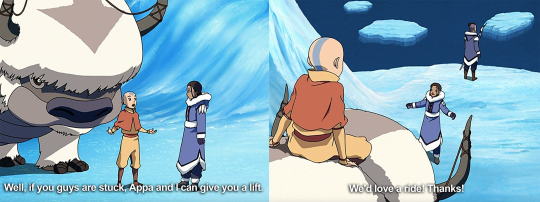
Aang: Well, if you guys are stuck, Appa and I can give you a lift. [Aang airbends himself onto Appa.]
Katara: We'd love a ride! Thanks! [Katara runs to the side of the bison.]
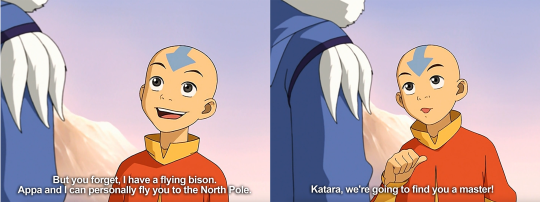
Aang: But you forget, I have a flying bison. [He happily points at himself.] Appa and I can personally fly you to the North Pole. Katara, we're going to find you a master!

Katara: [Happily.] I haven't done this since I was a kid!
Aang: You still are a kid!
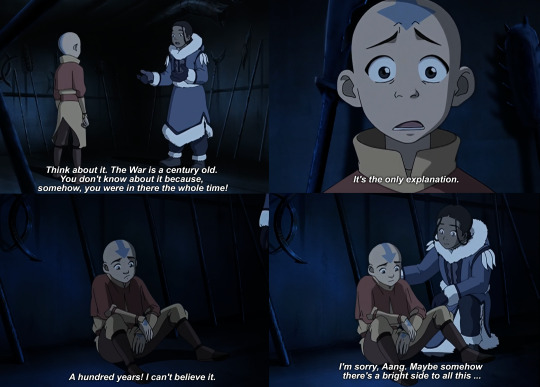
Katara: Think about it. The War is a century old. You don't know about it because, somehow, you were in there the whole time!
[Aang's expression changes to one of comprehension.]
Katara: It's the only explanation.
[Aang backs away and slumps to floor in shock.]
Aang: A hundred years! [Saddened by his new discovery.] I can't believe it.
Katara: [Squats beside him.] I'm sorry, Aang. Maybe somehow there's a bright side to all this ...
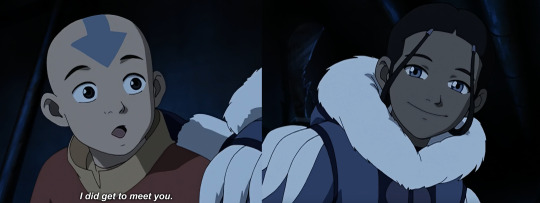
Aang: [Cheerfully.] I did get to meet you.
1.2 – The Avatar Returns

Kanna: [Worriedly.] Katara, you shouldn't have gone on that ship! Now we could all be in danger!
Aang: [Sorrowfully.] Don't blame Katara. I brought her there. It's my fault.
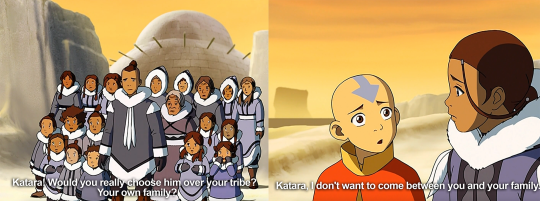
Sokka: Katara! Would you really choose him over your tribe? [Shows shot of the entire Southern Water Tribe.] Your own family?
A side-view-shot shows that Katara had stopped in her tracks, right between Appa and her tribe. Close-up of Katara, who looks down sorrowfully as Aang approaches her with a sad look upon his face.
Aang: [Understanding.] Katara, I don't want to come between you and your family.
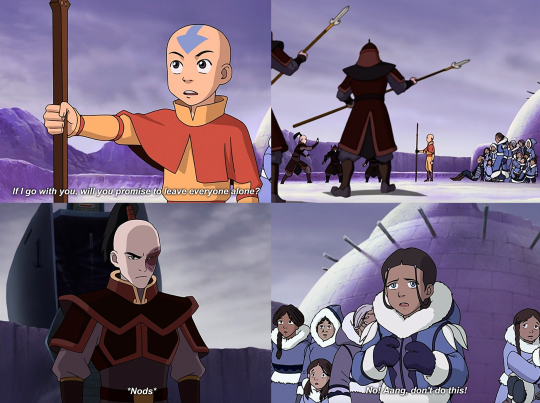
Aang: If I go with you, [He holds his staff in front of him as an offer, making sure Zuko understands that he does not wish to continue fighting.] will you promise to leave everyone alone?
The camera cuts to a side-view of the area, Zuko's men still surrounding him, spears poised. After a brief moment of hesitation, Zuko erects himself and nods in agreement. Aang is apprehended by Zuko's men, who take his staff.
Katara runs forward as they lead Aang away.
Katara: [Sadly.] No! Aang, don't do this!
Aang: [Surprisingly calm.] Don't worry, Katara. It'll be okay. [He gasps when he is shoved on the walkway. Katara's face contorts with sadness and fright.] Take care of Appa for me until I get back.

Katara: [Brightening a bit.] Well, if we go to the North Pole, you can master waterbending!
Aang: [Turning to face her, smiling and brightening up completely.] We can learn it together!
1.6 – Imprisoned
Aang: You must have really inspired him.

Katara: We can't abandon these people! There has to be a way to help them.
Aang: Maybe she's right. What do you say, Sokka?
1.7 – Winter Solstice, Part 1: The Spirit World
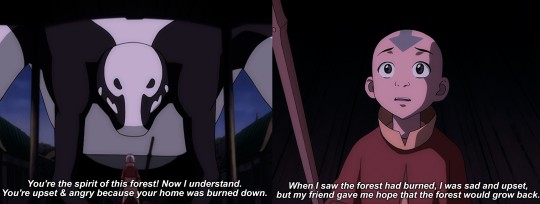
Aang: You're the spirit of this forest! Now I understand. You're upset and angry because your home was burned down. When I saw the forest had burned, I was sad and upset, but my friend gave me hope that the forest would grow back.
[He shows it the acorn and leaves it at his feet. The spirit picks it up and reverts to the panda form. It walks away peacefully. As it exits, a series of branches grow, and three villagers and Sokka emerge from it.]
1.9 – The Waterbending Scroll

Katara: [Surprised.] Wow, I can't believe you got that so quickly. It took me two months to learn that move.
Aang: [Shrugs shoulders.] Well, you had to figure it all on your own. I'm lucky enough to have a great teacher.
Katara: [Smiles.] Thanks.
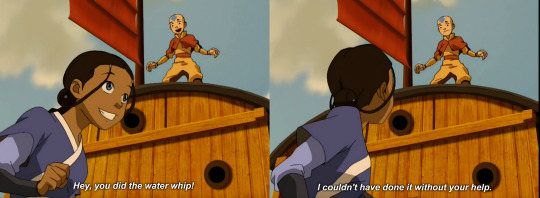
Aang: Hey, you did the water whip!
Katara: I couldn't have done it without your help.
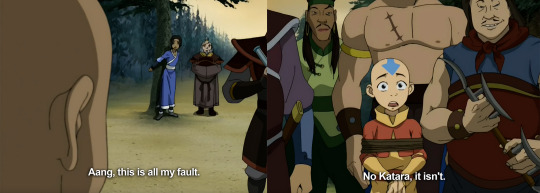
Katara: Aang, this is all my fault.
Aang: No Katara, it isn't.
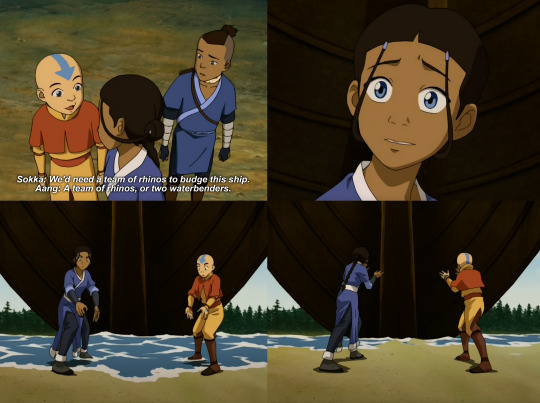
Sokka: We'd need a team of rhinos to budge this ship.
Aang: A team of rhinos, or two waterbenders.
Cuts to Aang and Katara pushing and pulling the water until the boat rises up.
1.14 The Fortuneteller

Aang: [Rises to his feet.] Not tangled. Woven! I made you a necklace, Katara. I thought since you lost your other one ...[He pauses in mid-sentence and displays the necklace, holding it between his hands as he flashes a toothy grin.]
Katara: [Smiling and approaching him.] Thanks, Aang. [Takes the necklace.] I love it.
1.15 – Bato of the Water Tribe

[ Zuko sends him three firebending blasts. Aang jumps to the other side of the well to dodge them. Zuko sends another fire blast at him. Aang ducks and notices Zuko is carrying Katara's necklace.]
Aang: You've got something I want.
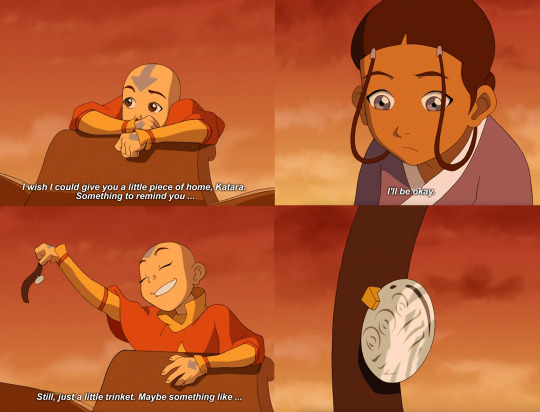
Aang: I wish I could give you a little piece of home, Katara. Something to remind you ...
Katara: I'll be okay.
Aang: Still, just a little trinket. Maybe something like ... [Holds up Katara's necklace.] this? [Closer shot of the necklace.]
Katara: [Takes the necklace.] Aang, how'd you get that?
1.16 The Deserter

[Katara enters the cottage to find Aang sulking.]
Aang: Jeong Jeong tried to tell me that I wasn't ready. I wouldn't listen. I'm never going to firebend again.
Katara: You'll have to eventually.
Aang: No, never again.
1.18 The Waterbending Master

Pakku: Here, the women learn from Yagoda to use their waterbending to heal. I'm sure she would be happy to take you as her student, despite your bad attitude.
Katara: I don't want to heal, I want to fight!
Pakku: I can see that. But our tribe has customs, rules.
Katara: [Furious.] Well, your rules stink!
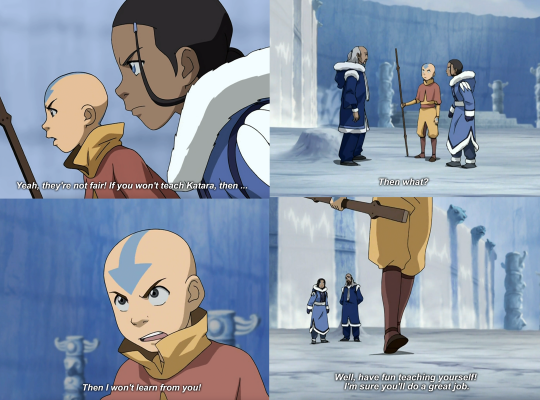
Aang[Also just as angry.]: Yeah, they're not fair! If you won't teach Katara, then ...
Pakku: Then what?
Aang: Then I won't learn from you!
Pakku: Well, have fun teaching yourself! I'm sure you'll do a great job.
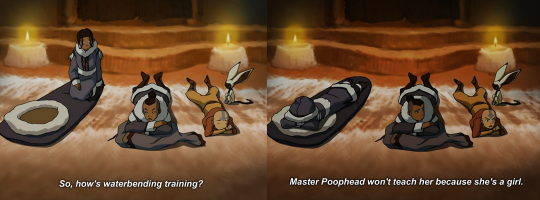
Sokka: No, it's Princess Yue. I don't get it, one minute she wants to go out with me, and the next, she's telling me to get lost. [Changing the topic.] So, how's waterbending training?
Aang: Master Poophead won't teach her because she's a girl.

Aang: [Bending up some water.] Master Pakku said this move is all about sinking and floating. [Sends the water to her.]
Katara: [Bending the water.] I got it!
[The water suddenly shoots upward.]
Aang: That was amazing!
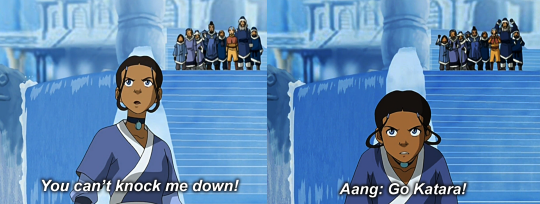
Katara: [Determined.] You can't knock me down!
[Some of the crowd cheers.]
Aang: Go, Katara!

Aang: Good to see you here.
Katara: You, too.
#avatar the last airbender#pro kataang#kataang defense squad#avatar aang#master katara#atla#katara#aang
148 notes
·
View notes
Text
Animal of the Day!
Great Blue Heron (Ardea herodias)

(Photo by Evan Lipton)
Conservation Status- Least Concern
Habitat- North America
Size (Weight/Length)- 2 kg; 1.2 m tall; 2 m wingspan
Diet- Fish; Amphibians; Insects; Crustaceans; Small rodents; Reptiles
Cool Facts- When you come across a body of water in North America, it is likely great blue herons are watching you from the bushes. These large, wading birds are masters of the shallows. Eating almost anything they can fit down their throat, great blue herons have been seen eating meter long snakes and even rabbits. The herons are practically invisible while hunting fish due to their ability to stand frozen and blend in with shore vegetation. During the breeding season, great blue herons gather in mass groups where their nests can be so heavy it causes branches to break. These areas are dubbed heronries with up to 500 nests in the immediate area.
Rating- 12/10 (I have to wear goggles when I work with them, they go for your eyes.)
Requested by @silelda
#animal of the day#animals#birds#herons#thursday#august 3#great blue heron#biology#science#conservation#the more you know#request#silelda
194 notes
·
View notes
Photo

This task in Finnish geography finals.
via u/PureRip3
Based on the map of the imaginary world source 1.A, choose the incorrect statement in sub-questions 1.1 to 1.10. There is only one incorrect statement in each sub-task. Some of the statements refer to items a-i on Map 1.A. Correct answer 2 p., wrong answer 0 p., no answer 0 p.
1.1 Land cover 2 p.
There is one lake in the area.
Only the northern parts of the area are marshes.
There are no surface waters in Mordor.
The area is mainly covered by forest.
1.2 Topography 2 p.
Mountains separate Mordor from the rest of the map.
Minas Tirith (a) is located in the river valley between the mountains.
Mount Doom (b) is visible from the town of Minas Tirith (a).
Edoras (c) is located on the lower slopes of the mountain range.
1.3 River network 2 p.
The Ringló river (d) flows down to the southwest.
The Ringló river (d) is not a branch of the Anduin (e).
Anduin (e) flows from south to north.
Edoras (c) is in the catchment area of Anduin (e).
1.4 Weather and climate 2 p.
The weather in the Lebennin area is often warmed by warm downdrafts.
The climate of the Lebennin region is wetter than that of the Anórien region.
The prevailing wind direction in the Lebennin area is from the sea.
The seaside balances the temperatures in the Lebennin area.
1.5 Road network 2 p.
The road from Minas Tirith (a) to Edoras (c) passes through the forest in two places.
The area between Minas Tirith (a), Morannon (f) and the northern parts of Mordor has the densest road network on the map.
The road from Edoras (c) to the Ringlo river (d) is longer than the road to Mount Doom (b).
The southern part of Mordor has a dense road network.
1.6 Interactions between regions 2 p.
The southern part of Mordor is peripheral.
Morannon (f) is a key transport hub.
Edoras (c) is the northernmost town in the region.
From Edoras (c) to Minas Tirith (a) there is both a road and a water route.
1.7 Air directions 2 p.
Minas Tirith (a) is located west of Anduin (e).
From Minas Tirith (a), the bay shown on the map is to the south-west.
Minas Tirith (a) is located east of Mordor.
From Minas Tirith (a), Mount Doom (b) is to the north-east.
1.8 Scale 2 p.
A proportional scale would be more appropriate for this map, which can be zoomed in and out.
The scale line indicates how much distance on this map corresponds to 100 km in nature.
The scale line indicates that the area shown on this map is about 350 kilometres wide in a south-north direction.
The scale line indicates that if the width of this map in the east-west direction were 45 centimetres when printed, its scale would be 1:1 000 000.
1.9 Distances and areas 2 p.
Minas Tirith (a) is about 100 km from Mount Doom (b).
The distance from Minas Tirith (a) to the sea by river is less than 400 km.
The plateau south of Morannon (f), surrounded by steep mountains, is less than 2 500 km2 .
Nindalf (g) is about 3 000 hectares in size.
1.10 Elevation curves 2 p.
The highest point of the Ephel Duath mountain range (h) is about 800 m above sea level.
Nindalf (g) is less than 200 metres above sea level.
The summit of Mount Doom (b) is about 200 metres above the surrounding area.
In the mountain area designated as site (i), the western slope is gentler than the eastern slope.
117 notes
·
View notes
Text
The Princess Royal visits a Save the Children shop in Wandsworth
Published 22 February 2024
The Princess Royal, as Patron of Save the Children UK, visited the charity's 'Mary's Living and Giving' shop in Wandsworth, as it celebrates 10 years since its opening.
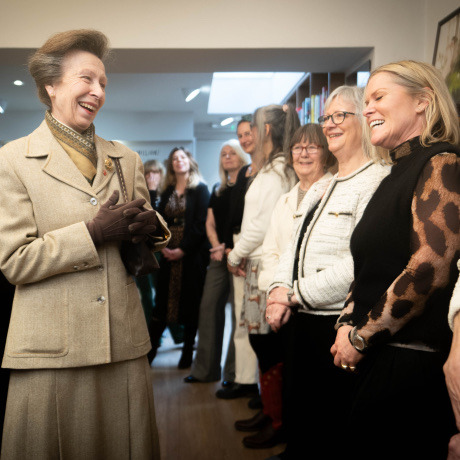
The Princess Royal has paid a special visit to 'Mary's Living and Giving' shop in Wandsworth, where Her Royal Highness thanked volunteers and staff for their ongoing work to raise money for Save the Children.

Save the Children aims to help every child get the chance of a future they deserve. In more than 100 countries, including the UK, the charity works to ensure children stay safe, healthy and learning – finding new ways to reach children who need it most.
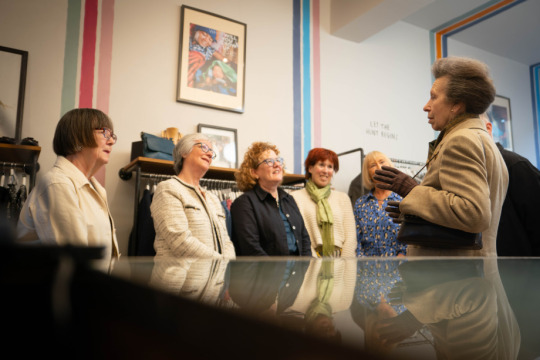
Save the Children has over 90 charity shops in total across the UK. 100% of the profits of items sold go directly to Save the Children’s work in the UK and around the world.

The charity’s Wandsworth shop branch has been running for 10 years and is operated by 35 volunteers. Over the past decade, the shop has raised over £1.2 million through sales for the charity’s work in the UK and around the world.
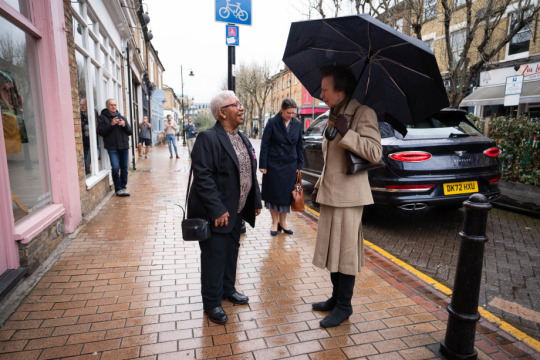
The Princess Royal first became President of Save the Children UK in 1970, before transitioning to the role of Patron in 2017.
Her Royal Highness has spent a significant amount of time visiting Save the Children projects in the UK and overseas, including places such as Uganda, Bangladesh, Sierra Leone, Mozambique, Bosnia and Herzegovina and most recently Sri Lanka, which she visited last month to commemorate 50 years of Save the Children operating in Sri Lanka.

#i LOVE charity shopping#you can find so many gems and the proceeds go to such worthy causes#also it’s great to have a declutter of your drawers and wardrobes and donate to the charity shops#which means more space for clothes#and more money for charities!!!#it’s a win win!!!#princess anne#princess royal
35 notes
·
View notes
Text
FOTD #056 : night-light mushroom! (mycena chlorophos)
the night-light mushroom (AKA green pepe) is a strongly bioluminescent mushroom in the family mycenaceae. this fungus occurs in forests on fallen woody debris such as dead twigs, branches, & logs. they have been found in india, japan, taiwan, polynesia, indonesia, sri lanka, australia & brazil !!
the big question : can i bite it??
ooh - the edibility of m. chlorophos is unknown.



m. chlorophos description :
"the cap is initially convex before flattening out (sometimes forming a central depression), & measures up to 30 mm (1.2 in) in diameter. the cap has radial grooves extending to nearly the centre, & sometimes develops cracks in the margin, which has small rounded teeth. its colour is pale brownish grey that fades after expansion, & it is somewhat sticky. the white stem is 6–30 mm (0.24–1.18 in) long by 0.3–1 mm thick, hollow, & translucent. it has tiny hairs on the surface. the base of the stem is disc-shaped or somewhat bulbous, measuring 1–2.5 mm wide. the thin gills are free from attachment to the stem, or are adnexed (narrowly attached) to a slight collar encircling the stem. initially white then greyish in colour, they are somewhat crowded, with 17–32 full-length gills & 1 to 3 tiers of lamellulae (shorter gills that do not extend fully from the cap margin to the stem). the gills are 0.3–1 mm wide with micaceous edges. both the caps & the gills are bioluminescent, while the mycelia & stems have little to no luminescence."
[images : source, source & source]
[fungus description : source]
"these mushrooms are so absolutely beautiful. the pictures of them always turn out so beautifully !! i would kill to see a glowing mushroom in person<3"
#• fungus of the day !! •#[mycena chlorophos]#: green pepe :#: night-light mushroom :#056#||#fungus#fungi#mycology#mushrooms#mushroom#earth#forestcore#foraging#nature#cottagecore#biology#fotd#fungus of the day#autism#special interest#mycena#mycena chlorophos#green pepe#bioluminescent#bioluminescence#night-light mushroom
77 notes
·
View notes
Text
Trubblegumm’s DTIYS—RAPH!
@trubblegumm this took so long 😂😅🥲 Not only did this take hours to make, I’m literally submitting this the day before the competition is over…
Procrastination and I have…a lot of history you could say
However, I had a lot of fun with this! I haven’t used these colored pencils in years, and it felt nice to use a gift my grandmother gave me—my goal for this year is to branch out and use new materials!!
Anyway, the first two don’t have blood, 1.1 is regular and 1.2 is filtered!


These last two have a little bit of blood, barely anything though! 2.1 is regular and 2.2 is filtered!


#rottmnt fanart#rise fanart#rise of the teenage mutant ninja turtles#rise raphael#rise of the tmnt#rise raph#raphael hamato#rottmnt raph#dtiys#trubblegumm3k#my art
202 notes
·
View notes
Text
Microsoft disponibiliza Windows 11 Insider Preview Build 25284
A Microsoft anunciou ontem, via Windows Blog, a disponibilização do Windows 11 Build 25284.1000 no âmbito do Windows Insider Program, para todos os utilizadores cujos PCs se encontram registados no Dev Channel.
Esta é a 30ª build da Active Development Branch a ser disponibilizada aos membros do Programa que entraram na RS_PRERELEASE.
(more…) “”

View On WordPress
#Active Development Branch#App Messenger#Build 25284#Dev Channel#Insider Preview#RS_PRERELEASE#vNext#Widget Board#Windows 11#Windows App SDK 1.2#Windows Update
0 notes
Text

𝐈𝐧 𝐎𝐛𝐬𝐞𝐫𝐯𝐚𝐧𝐜𝐞 𝐨𝐟 𝐌𝐞𝐦𝐨𝐫𝐢𝐚𝐥 𝐃𝐚𝐲🇺🇸
Falling every year on the last Monday of May, Memorial Day honors the men and women who died while serving in all branches of the U.S. military-nearly 1.2 million military personnel in all conflicts since the Revolutionary War.
18 notes
·
View notes
Text
New Event PV
youtube
New Operators

Harold, 5* Welfare Wandering Medic
Come to me, do you want to look for a place to soak up the sun?
Лeto, 5* Lord Guard
Doctor, have you studied the language here? What's this word for?
Degenbrecher, 6* Swordmaster Guard
Tell me with your weapons, who you are.
Keep up, loser gets no supper today.
Operator Skins Update
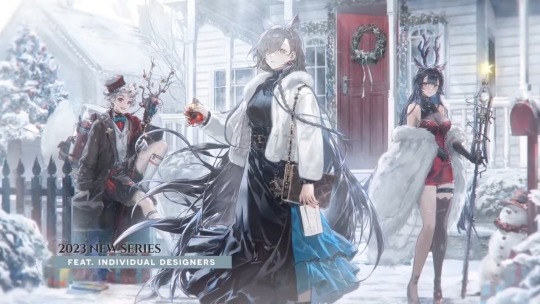





Total of 5 new skins, 3 new additions for the Icefield Messenger brand and 2 new additions for the Epoque brand
Icefield Messenger
Penance's 偶尔醉陶 (Occasionally Intoxicated)
Tsukinogi's 舞 (Dance)
Qanipalaat's 回礼 (Return Gifts)
Epoque
Ansel's Nighttime Café - Login Event Skin
Puzzle's Amidst the Pieces
Puzzle's skin will be up for sale during What the Firelight Casts Retrospect

Announced a rerun for series III of the Icefield Messenger skins, up for sale during the same time as the new Icefield Messenger skins
Operator Modules Update



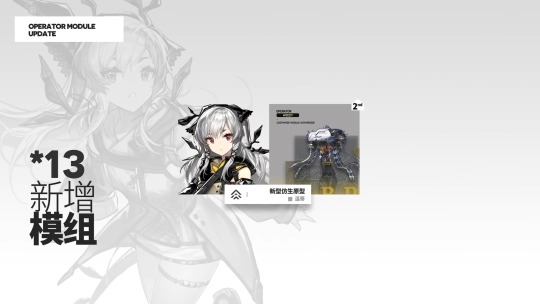
Degenbrecher being part of the Swordmaster branch immediately gets her module
SWO-X module base effect makes Degenbrecher deal +10% more damage with skills
Mech-Accord Caster branch gets 2 module types
Module 1 given to Goldenglow and Rockrock
Module 2 given to Kjera, Minimalist and Click
Incantation Medic branch gets 1 module type
Lee, Suzuran, Carnelian and Weedy get their second modules
DEC-Y module base effect extends the duration of Suzuran's Slow debuff to 1.2 seconds
PUS-Y module base effect increases Weedy's push force by 1 when she is blocking at least 2 enemies
The base effect of MER-Y and PLX-Y modules are unknown at the time of writing
Events and Stories
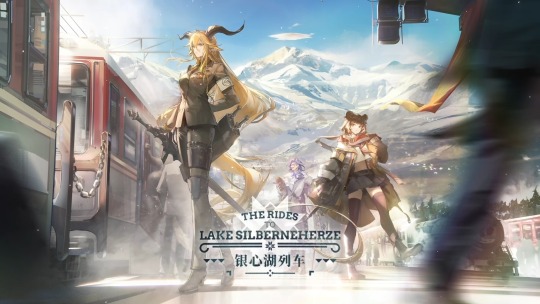
The Rides to Lake Silberneherze, a Kjerag side story event
Yes, sir, this train's stop is at Lake Silberneherze.
Once you exit the station, you can admire the statue of Kjeragandr up close. However, there is still some time before the inauguration ceremony, and there are still areas under construction and repairs. We thank you for your understanding.
Are you looking for a spot overlooking the city? Then you'll have to put in some effort to climb the nearby Mount Furrgen. However no worries, there are "running burdenbeasts" next to the station to help you. At the foot of the mountain there's also a cable car station that can get you to the top.
My Victorian is good? Ah, thank you for your compliment. Mastering at least one foreign language is an essential skill for today's attendants.
Are you from Victoria? Kjerag welcomes you.

What the Firelight Casts Retrospect, scheduled after The Rides to Lake Silberneherze

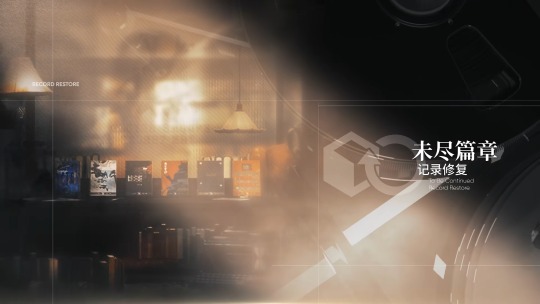
Operator Archives update for Gnosis, Лeto, Kjera and Astesia
Record Restore update for To Be Continued
Misc Stuff
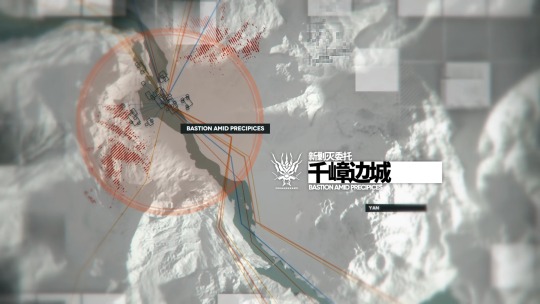

Annihilation #23 - Bastion Amid Precipices, annihilation mission with Where Vernal Winds Will Never Blow enemies and mechanics
SSS New Season #4, Rim Zone Security Service - Tower Mountains Life Sciences & Terran Society for the Protection of Durin People
25 notes
·
View notes
Text

G.1 Are individualist anarchists anti-capitalist?
To answer this question, it is necessary to first define what we mean by capitalism and socialism. While there is a tendency for supporters of capitalism (and a few socialists!) to equate it with the market and private property, this is not the case. It is possible to have both and not have capitalism (as we discuss in section G.1.1 and section G.1.2, respectively). Similarly, the notion that “socialism” means, by definition, state ownership and/or control, or that being employed by the state rather than by private capital is “socialism” is distinctly wrong. While some socialists have, undoubtedly, defined socialism in precisely such terms, socialism as a historic movement is much wider than that. As Proudhon put it, ”[m]odern Socialism was not founded as a sect or church; it has seen a number of different schools.” [Selected Writings of Pierre-Joseph Proudhon, p. 177]
As Proudhon, Bakunin, Kropotkin and Tucker all stressed, anarchism is one of those schools. For Kropotkin, anarchism was “the no-government system of socialism.” [Anarchism, p. 46] Likewise, for Tucker, there were “two schools of socialistic thought”, one of which represented authority and the other liberty, namely “State Socialism and Anarchism.” [The Individualist Anarchists, pp. 78–9] It was “not Socialist Anarchism against Individualist Anarchism, but of Communist Socialism against Individualist Socialism.” [Tucker, Liberty, no. 129, p. 2] As one expert on Individualist Anarchism noted, Tucker “looked upon anarchism as a branch of the general socialist movement.” [James J. Martin, Men Against the State, pp. 226–7] Thus we find Individualist anarchist Victor Yarros, like Tucker, talking about “the position and teachings of the Anarchistic Socialists” when referring to his ideas. [Liberty, no. 98, p. 5]
Part of problem is that in the 20th century, the statist school of socialism prevailed both within the labour movement (at least in English speaking countries or until fascism destroyed it in mainland Europe and elsewhere) and within the revolutionary movement (first as social democracy, then as Communism after the Russian Revolution). This lead, it should be noted, to anarchists not using the term “socialist” to describe their ideas as they did not want to be confused with either reformed capitalism (social democracy) or state capitalism (Leninism and Stalinism). As anarchism was understood as being inherently anti-capitalist, this did not become an issue until certain right-wing liberals started calling themselves “anarcho”-capitalists (somewhat ironically, these liberals joined with the state socialists in trying to limit anarchism to anti-statism and denying their socialist credentials). Another part of the problem is that many, particularly those in America, derive their notion of what socialism is from right-wing sources who are more than happy to agree with the Stalinists that socialism is state ownership. This is case with right-“libertarians”, who rarely study the history or ideas of socialism and instead take their lead from such fanatical anti-socialists as Ludwig von Mises and Murray Rothbard. Thus they equate socialism with social democracy or Leninism/Stalinism, i.e. with state ownership of the means of life, the turning of part or the whole working population into employees of the government or state regulation and the welfare state. In this they are often joined by social democrats and Marxists who seek to excommunicate all other kinds of socialism from the anti-capitalist movement.
All of which leads to some strange contradictions. If “socialism” is equated to state ownership then, clearly, the individualist anarchists are not socialists but, then, neither are the social anarchists! Thus if we assume that the prevailing socialism of the 20th century defines what socialism is, then quite a few self-proclaimed socialists are not, in fact, socialists. This suggests that socialism cannot be limited to state socialism. Perhaps it would be easier to define “socialism” as restrictions on private property? If so, then, clearly, social anarchists are socialists but then, as we will prove, so are the individualist anarchists!
Of course, not all the individualist anarchists used the term “socialist” or “socialism” to describe their ideas although many did. Some called their ideas Mutualism and explicitly opposed socialism (William Greene being the most obvious example). However, at root the ideas were part of the wider socialist movement and, in fact, they followed Proudhon in this as he both proclaimed himself a socialist while also attacking it. The apparent contradiction is easily explained by noting there are two schools of socialism, state and libertarian. Thus it is possible to be both a (libertarian) socialist and condemn (state) socialist in the harshest terms.
So what, then, is socialism? Tucker stated that “the bottom claim of Socialism” was “that labour should be put in possession of its own,” that “the natural wage of labour is its product” and “interest, rent, and profit … constitute the trinity of usury.” [The Individualist Anarchists, p. 78 and p. 80] This definition also found favour with Kropotkin who stated that socialism “in its wide, generic, and true sense” was an “effort to abolish the exploitation of labour by capital.” [Anarchism, p. 169] For Kropotkin, anarchism was “brought forth by the same critical and revolutionary protest which gave rise to Socialism in general”, socialism aiming for “the negation of Capitalism and of society based on the subjection of labour to capital.” Anarchism, unlike other socialists, extended this to oppose “what constitutes the real strength of Capitalism: the State and its principle supports.” [Environment and Evolution, p. 19] Tucker, similarly, argued that Individualist anarchism was a form of socialism and would result in the “emancipation of the workingman from his present slavery to capital.” [Instead of a Book, p. 323]
The various schools of socialism present different solutions to this exploitation and subjection. From the nationalisation of capitalist property by the state socialists, to the socialisation of property by the libertarian communists, to the co-operatives of mutualism, to the free market of the individualist anarchists, all are seeking, in one way or the other, to ensure the end of the domination and exploitation of labour by capital. The disagreements between them all rest in whether their solutions achieve this aim and whether they will make life worth living and enjoyable (which also explains why individualist and social anarchists disagree so much!). For anarchists, state socialism is little more than state capitalism, with a state monopoly replacing capitalist monopolies and workers being exploited by one boss (the state) rather than many. So all anarchists would agree with Yarrows when he argued that ”[w]hile State Socialism removes the disease by killing the patient, no-State Socialism offers him the means of recovering strength, health, and vigour.” [Liberty, no. 98, p. 5]
So, why are the individualist anarchists anti-capitalists? There are two main reasons.
Firstly, the Individualist Anarchists opposed profits, interest and rent as forms of exploitation (they termed these non-labour incomes “usury”, but as Tucker stressed usury was “but another name for the exploitation of labour.” [Liberty, no. 122, p. 4]). To use the words of Ezra Heywood, the Individualist Anarchists thought “Interest is theft, Rent Robbery, and Profit Only Another Name for Plunder.” [quoted by Martin Blatt, “Ezra Heywood & Benjamin Tucker,”, pp. 28–43, Benjamin R. Tucker and the Champions of Liberty, Coughlin, Hamilton and Sullivan (eds.), p. 29] Non-labour incomes are merely “different methods of levying tribute for the use of capital.” Their vision of the good society was one in which “the usurer, the receiver of interest, rent and profit” would not exist and Labour would “secure its natural wage, its entire product.” [Tucker, The Individualist Anarchists, p. 80, p. 82 and p. 85] This would also apply to dividends, “since no idle shareholders could continue in receipt of dividends were it not for the support of monopoly, it follows that these dividends are no part of the proper reward of ability.” [Tucker, Liberty, no. 282, p. 2]
In addition, as a means of social change, the individualists suggested that activists start “inducing the people to steadily refuse the payment of rents and taxes.” [Instead of a Book pp. 299–300] These are hardly statements with which capitalists would agree. Tucker, as noted, also opposed interest, considering it usury (exploitation and a “crime”) pure and simple and one of the means by which workers were denied the full fruits of their labour. Indeed, he looked forward to the day when “any person who charges more than cost for any product [will] … be regarded very much as we now regard a pickpocket.” This “attitude of hostility to usury, in any form” hardly fits into the capitalist mentality or belief system. [Op. Cit., p. 155] Similarly, Ezra Heywood considered profit-taking “an injustice which ranked second only to legalising titles to absolute ownership of land or raw-materials.” [James J. Martin, Op. Cit., p. 111] Opposition to profits, rent or interest is hardly capitalistic — indeed, the reverse.
Thus the Individualist Anarchists, like the social anarchists, opposed the exploitation of labour and desired to see the end of capitalism by ensuring that labour would own what it produced. They desired a society in which there would no longer be capitalists and workers, only workers. The worker would receive the full product of his/her labour, so ending the exploitation of labour by capital. In Tucker’s words, a free society would see “each man reaping the fruits of his labour and no man able to live in idleness on an income from capital” and so society would “become a great hive of Anarchistic workers, prosperous and free individuals” combining “to carry on their production and distribution on the cost principle.” [The Individualist Anarchists, p. 276]
Secondly, the Individualist Anarchists favoured a new system of land ownership based on “occupancy and use.” So, as well as this opposition to capitalist usury, the individualist anarchists also expressed opposition to capitalist ideas on property (particularly property in land). J.K. Ingalls, for example, considered that “the private domination of the land” originated in “usurpation only, whether of the camp, the court or the market. Whenever such a domination excludes or deprives a single human being of his equal opportunity, it is a violation, not only of the public right, and of the social duty, but of the very principle of law and morals upon which property itself is based.” [quoted by Martin, Op. Cit., p. 148f] As Martin comments, for Ingalls, ”[t]o reduce land to the status of a commodity was an act of usurpation, enabling a group to ‘profit by its relation to production’ without the expenditure of labour time.” [Op. Cit., p. 148] These ideas are identical to Proudhon’s and Ingalls continues in this Proudhonian “occupancy and use” vein when he argues that possession “remains possession, and can never become property, in the sense of absolute dominion, except by positive statue [i.e. state action]. Labour can only claim occupancy, and can lay no claim to more than the usufruct.” Current property ownership in land were created by “forceful and fraudulent taking” of land, which “could give no justification to the system.” [quoted by Martin, Op. Cit., p. 149]
The capitalist system of land ownership was usually termed the “land monopoly”, which consisted of “the enforcement by government of land titles which do not rest upon personal occupancy and cultivation.” Under anarchism, individuals would “no longer be protected by their fellows in anything but personal occupancy and cultivation of land” and so “ground rent would disappear.” [Tucker, The Individualist Anarchists, p. 85] This applied to what was on the land as well, such as housing:
“If a man exerts himself by erecting a building on land which afterward, by the operation of the principle of occupancy and use, rightfully becomes another’s, he must, upon demand of the subsequent occupant, remove from this land the results of his self-exertion, or, failing so to do, sacrifice his property therein.” [Liberty, no. 331, p. 4]
This would apply to both the land and what was on it. This meant that “tenants would not be forced to pay … rent” nor would landlords “be allowed to seize their property.” This, as Tucker noted, was a complete rejection of the capitalist system of property rights and saw anarchism being dependent on “the Anarchistic view that occupancy and use should condition and limit landholding becom[ing] the prevailing view.” [The Individualist Anarchists, p. 162 and p. 159] As Joseph Labadie put it, socialism includes any theory “which has for its object the changing of the present status of property and the relations one person or class holds to another. In other words, any movement which has for its aim the changing of social relations, of companionships, of associations, of powers of one class over another class, is Socialism.” [our emphasis, Liberty, no. 158, p. 8] As such, both social and individualist anarchists are socialists as both aimed at changing the present status of property.
It should also be noted here that the individualist anarchist ideal that competition in banking would drive interest to approximately zero is their equivalent to the social anarchist principle of free access to the means of life. As the only cost involved would be an administration charge which covers the labour involved in running the mutual bank, all workers would have access to “capital” for (in effect) free. Combine this with “occupancy and use” in terms of land use and it can be seen that both individualist and social anarchists shared a common aim to make the means of life available to all without having to pay a tribute to an owner or be dependent on a ruling capitalist or landlord class.
For these reasons, the Individualist Anarchists are clearly anti-capitalist. While an Individualist Anarchy would be a market system, it would not be a capitalist one. As Tucker argued, the anarchists realised “the fact that one class of men are dependent for their living upon the sale of their labour, while another class of men are relieved of the necessity of labour by being legally privileged to sell something that is not labour… . And to such a state of things I am as much opposed as any one. But the minute you remove privilege… every man will be a labourer exchanging with fellow-labourers … What Anarchistic-Socialism aims to abolish is usury … it wants to deprive capital of its reward.” As noted above, the term “usury,” for Tucker, was simply a synonym for “the exploitation of labour.” [Instead of a Book, p. 404 and p. 396]
The similarities with social anarchism are obvious. Like them, the individualist anarchists opposed capitalism because they saw that profit, rent and interest were all forms of exploitation. As communist-anarchist Alexander Berkman noted, ”[i]f the worker would get his due — that is, the things he produces or their equivalent — where would the profits of the capitalist come from? If labour owned the wealth it produced, there would be no capitalism.” Like social anarchists they opposed usury, to have to pay purely for access/use for a resource. It ensured that a “slice of their daily labour is taken from [the workers] for the privilege of using these factories” [What is Anarchism?, p. 44 and p. 8] For Marx, abolishing interest and interest-bearing capital “means the abolition of capital and of capitalist production itself.” [Theories of Surplus Value, vol. 3, p. 472] A position, incidentally, also held by Proudhon who maintained that “reduction of interest rates to vanishing point is itself a revolutionary act, because it is destructive of capitalism.” [quoted by Edward Hyams, Pierre-Joseph Proudhon: His Revolutionary Life, Mind and Works, p. 188] Like many socialists, Individualist Anarchists used the term “interest” to cover all forms of surplus value: “the use of money” plus “house-rent, dividends, or share of profits” and having to “pay a tax to somebody who owns the land.” “In doing away with interest, the cause of inequality in material circumstances will be done away with.” [John Beverley Robinson, The Individualist Anarchists, pp. 144–5]
Given that Individualist Anarchism aimed to abolish interest along with rent and profit it would suggest that it is a socialist theory. Unsurprisingly, then, Tucker agreed with Marx’s analysis on capitalism, namely that it lead to industry concentrating into the hands of a few and that it robbed workers of the fruits of the toil (for Francis Tandy it was a case of “the Marxian theory of surplus value, upon which all Socialistic philosophy — whether State or Anarchistic — is necessarily based” [Op. Cit., no. 312, p. 3]). Tucker quoted a leading Marxist’s analysis of capitalism and noted that “Liberty endorses the whole of it, excepting a few phrases concerning the nationalisation of industry and the assumption of political power by working people.” However, he was at pains to argue that this analysis was first expounded by Proudhon, “that the tendency and consequences of capitalistic production … were demonstrated to the world time and time again during the twenty years preceding the publication of ‘Das Kapital’” by the French anarchist. This included “the historical persistence of class struggles in successive manifestations” as well as “the theory that labour is the source and measure of value.” “Call Marx, then, the father of State socialism, if you will,” argued Tucker, “but we dispute his paternity of the general principles of economy on which all schools of socialism agree.” [Liberty, no. 35, p. 2]
This opposition to profits, rent and interest as forms of exploitation and property as a form of theft clearly makes individualist anarchism anti-capitalist and a form of (libertarian) socialism. In addition, it also indicates well the common ground between the two threads of anarchism, in particular their common position to capitalism. The social anarchist Rudolf Rocker indicates well this common position when he argues:
“it is difficult to reconcile personal freedom with the existing economic system. Without doubt the present inequality of economic interests and the resulting class conflicts in society are a continual danger to the freedom of the individual … [T]he undisturbed natural development of human personality is impossible in a system which has its root in the shameless exploitation of the great mass of the members of society. One cannot be free either politically or personally so long as one is in economic servitude of another and cannot escape from this condition. This was recognised by men like Godwin, Warren, Proudhon, Bakunin, [and women like Goldman and de Cleyre, we must add!] and many others who subsequently reached the conviction that the domination of man over man will not disappear until there is an end of the exploitation of man by man.” [Nationalism and Culture, p. 167]
There are other, related, reasons why the individualist anarchists must be considered left-wing libertarians rather than right-wing ones. Given their opposition to non-labour income, they saw their proposals as having egalitarian implications. As regards equality, we discover that they saw their ideas as promoting it. Thus we find Tucker arguing that that the “happiness possible in any society that does not improve upon the present in the matter of distribution of wealth, can hardly be described as beatific.” He was clearly opposed to “the inequitable distribution of wealth” under capitalism and equally clearly saw his proposals as a means of reducing it substantially. The abolition of those class monopolies which create interest, rent and profit would reduce income and wealth inequalities substantially. However, there was “one exception, and that a comparatively trivial one”, namely economic rent (the natural differences between different bits of land and individual labour). This “will probably remain with us always. Complete liberty will very much lessen it; of that I have no doubt … At the worst, it will be a small matter, no more worth consideration in comparison with the liberty than the slight disparity that will always exist in consequence of inequalities of skill.” [“Why I am an Anarchist”, pp. 132–6, Man!, M. Graham (ed.), pp. 135–6] Another individualist anarchist, John Beverley Robinson, agreed:
“When privilege is abolished, and the worker retains all that he produces, then will come the powerful trend toward equality of material reward for labour that will produce substantial financial and social equality, instead of the mere political equality that now exists.” [Patterns of Anarchy, pp. 278–9]
As did Lysander Spooner, who pointed out that the “wheel of fortune, in the present state of things, is of such enormous diameter” and “those on its top are on so showy a height” wjile “those underneath it are in such a pit of debt, oppression, and despair.” He argued that under his system “fortunes could hardly be represented by a wheel; for it would present no such height, no such depth, no such irregularity of motion as now. It should rather be represented by an extended surface, varied somewhat by inequalities, but still exhibiting a general level, affording a safe position for all, and creating no necessity, for either force or fraud, on the part of anyone to secure his standing.” Thus Individualist anarchism would create a condition “neither of poverty, nor riches; but of moderate competency — such as will neither enervate him by luxury, nor disable him by destitution; but which will at once give him and opportunity to labour, (both mentally and physically) and stimulate him by offering him all the fruits of his labours.” [quoted by Stephan L. Newman, Liberalism at Wit’s End, p. 72 and p. 73]
As one commentator on individualist anarchism, Wm. Gary Kline, correctly tsummarised:
“Their proposals were designed to establish true equality of opportunity … and they expected this to result in a society without great wealth or poverty. In the absence of monopolistic factors which would distort competition, they expected a society of largely self-employed workmen with no significant disparity of wealth between any of them since all would be required to live at their own expense and not at the expense of exploited fellow human beings.” [The Individualist Anarchists: A Critique of Liberalism, pp. 103–4]
Hence, like social anarchists, the Individualist Anarchists saw their ideas as a means towards equality. By eliminating exploitation, inequality would soon decrease as wealth would no longer accumulate in the hands of the few (the owners). Rather, it would flow back into the hands of those who produced it (i.e. the workers). Until this occurred, society would see ”[o]n one side a dependent class of wage-workers and on the other a privileged class of wealth-monopolisers, each become more and more distinct from the other as capitalism advances.” This has “resulted in a grouping and consolidation of wealth which grows apace by attracting all property, no matter by whom produced, into the hands of the privileged, and hence property becomes a social power, an economic force destructive of rights, a fertile source of injustice, a means of enslaving the dispossessed.” [William Ballie, The Individualist Anarchists, p. 121]
Moreover, like the social anarchists, the Individualist Anarchists were aware that the state was not some neutral machine or one that exploited all classes purely for its own ends. They were aware that it was a vehicle of class rule, namely the rule of the capitalist class over the working class. Spooner thought that that “holders of this monopoly [of the money supply] now rule and rob this nation; and the government, in all its branches, is simply their tool” and that “the employers of wage labour … are also the monopolists of money.” [Spooner, A Letter to Grover Cleveland, p. 42 and p. 48] Tucker recognised that “capital had so manipulated legislation” that they gained an advantage on the capitalist market which allowed them to exploit labour. [The Individualist Anarchists, pp. 82–3] He was quite clear that the state was a capitalist state, with “Capitalists hav[ing] placed and kept on the statute books all sorts of prohibitions and taxes” to ensure a “free market” skewed in favour of themselves. [Instead of a Book, p. 454] A.H. Simpson argued that the Individualist Anarchist “knows very well that the present State … is simply the tool of the property-owning class.” [The Individualist Anarchists, p. 92] Thus both wings of the anarchist movement were united in their opposition to capitalist exploitation and their common recognition that the state was a tool of the capitalist class, used to allow them to exploit the working class.
Tucker, like other individualist anarchists, also supported labour unions, and although he opposed violence during strikes he recognised that it was caused by frustration due to an unjust system. Indeed, like social anarchists, he considered “the labourer in these days [as] a soldier… His employer is … a member of an opposing army. The whole industrial and commercial world is in a state of internecine war, in which the proletaires are massed on one side and the proprietors on the other.” The cause of strikes rested in the fact that “before … strikers violated the equal liberty of others, their own right to equality of liberty had been wantonly and continuously violated” by the capitalists using the state, for the “capitalists … in denying [a free market] to [the workers] are guilty of criminal invasion.” [Instead of a Book, p. 460 and p. 454] “With our present economic system,” Tucker stressed, “almost every strike is just. For what is justice in production and distribution? That labour, which creates all, shall have all.” [Liberty, no. 19, p. 1]
Another important aspects of unions and strikes were that they represented both a growing class consciousness and the ability to change society. “It is the power of the great unions to paralyse industry and ignore the government that has alarmed the political burglars,” argued Victor Yarrows. This explained why unions and strikes were crushed by force as “the State can have no rival, say the plutocrats, and the trades unions, with the sympathetic strike and boycott as weapons, are becoming too formidable.” Even defeated strikes were useful as they ensured that “the strikers and their sympathisers will have acquired some additional knowledge of the essential nature of the beast, government, which plainly has no other purpose at present than to protect monopoly and put down all opposition to it.” “There is such a thing as the solidarity of labour,” Yarrows went on, “and it is a healthy and encouraging sign that workmen recognise the need of mutual support and co-operation in their conflict with monopoly and its official and unofficial servants. Labour has to fight government as well as capital, ‘law and order’ as well as plutocracy. It cannot make the slightest movement against monopoly without colliding with some sort of ‘authority’, Federal, State, or municipal.” The problem was that the unions “have no clear general aims and deal with results rather than causes.” [Liberty, no. 291, p. 3]
This analysis echoed Tucker’s, who applauded the fact that ”[a]nother era of strikes apparently is upon us. In all trades and in all sections of the country labour is busy with its demands and its protests. Liberty rejoices in them. They give evidence of life and spirit and hope and growing intelligence. They show that the people are beginning to know their rights, and, knowing, dare to maintain them. Strikes, whenever and wherever inaugurated, deserve encouragement from all true friends of labour.” [Op. Cit., no. 19, p. 1] Even failed strikes were useful, for they exposed “the tremendous and dangerous power now wielded by capital.” [Op. Cit., no. 39, p. 1] The “capitalists and their tools, the legislatures, already begin to scent the impending dangers of trades-union socialism and initiatory steps are on foot in the legislatures of several states to construe labour combinations as conspiracies against commerce and industry, and suppress them by law.” [Op. Cit., no. 22, p. 3]
Some individualist anarchists, like Dyer Lum and Joseph Labadie, were union organisers while Ezra Heywood “scoffed at supporters of the status quo, who saw no evidence of the tyranny on the part of capital, and who brought up the matter of free contract with reference to labourers. This argument was no longer valid. Capital controlled land, machinery, steam power, waterfalls, ships, railways, and above all, money and public opinion, and was in a position to wait out recalcitrancy at its leisure.” [Martin, Op. Cit., p. 107] For Lum, “behind the capitalist … privilege stands as support” and so social circumstances matter. “Does liberty exist,” he argued, “where rent, interest, and profit hold the employee in economic subjection to the legalised possessor of the means of life? To plead for individual liberty under the present social conditions, to refuse to abate one jot of control that legalised capital has over individual labour, and to assert that the demand for restrictive or class legislation comes only from the voluntary associations of workmen [i.e., trade unions] is not alone the height of impudence, but a barefaced jugglery of words.” [Liberty, no. 101, p. 5]
Likewise, Tucker advocated and supported many other forms of non-violent direct action as well as workplace strikes, such as boycotts and rent strikes, seeing them as important means of radicalising the working class and creating an anarchist society. However, like social anarchists the Individualist Anarchists did not consider labour struggle as an end in itself — they considered reforms (and discussion of a “fair wage” and “harmony between capital and labour”) as essentially “conservative” and would be satisfied with no less than “the abolition of the monopoly privileges of capital and interest-taking, and the return to labour of the full value of its production.” [Victor Yarros, quoted by Martin, Op. Cit., p. 206f]
Therefore, it is clear that both social and Individualist Anarchists share much in common, including an opposition to capitalism. The former may have been in favour of free exchange but between equally situated individuals. Only given a context of equality can free exchange be considered to benefit both parties equally and not generate growing inequalities which benefit the stronger of the parties involved which, in turn, skews the bargaining position of those involved in favour of the stronger (also see section F.3).
It is unsurprising, therefore, that the individualist anarchists considered themselves as socialists. Like Proudhon, they desired a (libertarian) socialist system based on the market but without exploitation and which rested on possession rather than capitalist private property. With Proudhon, only the ignorant or mischievous would suggest that such a system was capitalistic. The Individualist Anarchists, as can be seen, fit very easily into Kropotkin’s comments that “the anarchists, in common with all socialists … maintain that the now prevailing system of private ownership in land, and our capitalist production for the sake of profits, represent a monopoly which runs against both the principles of justice and the dictates of utility.” [Anarchism, p. 285] While they rejected the communist-anarchist solution to the social question, they knew that such a question existed and was rooted in the exploitation of labour and the prevailing system of property rights.
So why is Individualist Anarchism and Proudhon’s mutualism socialist? Simply because they opposed the exploitation of labour by capital and proposed a means of ending it. The big debate between social and individualist anarchists is revolves around whether the other school can really achieve this common goal and whether its proposed solution would, in fact, secure meaningful individual liberty for all.
#faq#anarchy faq#revolution#anarchism#daily posts#communism#anti capitalist#anti capitalism#late stage capitalism#organization#grassroots#grass roots#anarchists#libraries#leftism#social issues#economy#economics#climate change#climate crisis#climate#ecology#anarchy works#environmentalism#environment#solarpunk#anti colonialism#mutual aid#cops#police
8 notes
·
View notes